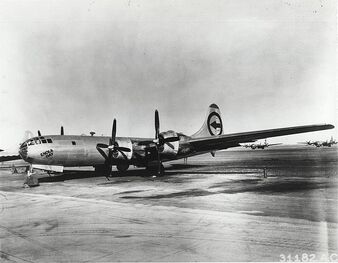
Enola Gay on the ground, showing the arrowhead painted on the tail in place of the group letter
The Enola Gay is a Boeing B-29 Superfortress. It is famed for dropping the world's first nuclear bomb used in warfare, which was dropping the Little Boy on Hiroshima on August 6, 1945.
Naming[]
The aircraft was named for the mother of Colonel Paul Tibbets, who flew the aircraft on the Hiroshima mission.
History[]
Enola Gay was one of the 536 B-29s built at the Martin-Omaha plant from mid 1944. Following delivery to the US Twelfth Air Force, the aircraft was assigned to the 393rd Bombardment Squadron (VH) of the 315th Bombardment Wing, receiving individual aircraft number 82.
World War II[]
Hiroshima was the primary target of the first nuclear bombing mission on 6 August, with Kokura and Nagasaki as alternative targets. Enola Gay, piloted by Tibbets, took off from North Field, in the Mariana Islands, about six hours' flight time from Japan, accompanied by two other B-29s, The Great Artiste, carrying instrumentation, and a then-nameless aircraft later called Necessary Evil, commanded by Captain George Marquardt, to take photographs. The director of the Manhattan Project, Major General Leslie R. Groves, Jr., wanted the event recorded for posterity, so the takeoff was illuminated by floodlights. When he wanted to taxi, Tibbets leaned out the window to direct the bystanders out of the way. On request, he gave a friendly wave for the cameras.
After leaving Tinian, the aircraft made their way separately to Iwo Jima, where they rendezvoused at 2,440 meters (8,010 ft) and set course for Japan. The aircraft arrived over the target in clear visibility at 9,855 meters (32,333 ft). Captain William S. "Deak" Parsons of Project Alberta, who was in command of the mission, armed the bomb during the flight to minimize the risks during takeoff. His assistant, Second Lieutenant Morris R. Jeppson, removed the safety devices 30 minutes before reaching the target area.
The release at 08:15 (Hiroshima time) went as planned, and the Little Boy took 43 seconds to fall from the aircraft flying at 31,060 feet (9,470 m) to the predetermined detonation height about 1,968 feet (600 m) above the city. Enola Gay traveled 11.5 mi (18.5 km) before it felt the shock waves from the blast.[14] Although buffeted by the shock, neither Enola Gay nor The Great Artiste was damaged.[15]
The detonation created a blast equivalent to 16 kilotons of TNT (67 TJ). The U-235 weapon was considered very inefficient, with only 1.7% of its fissile material fissioning.[17] The radius of total destruction was about one mile (1.6 km), with resulting fires across 4.4 square miles (11 km2). Americans estimated that 4.7 square miles (12 km2) of the city were destroyed. Japanese officials determined that 69% of Hiroshima's buildings were destroyed and another 6–7% damaged.[19] Some 70,000–80,000 people, 30% of the city's population, were killed by the blast and resultant firestorm,[20] and another 70,000 injured. Out of those killed, 20,000 were soldiers.
Enola Gay returned safely to its base on Tinian to great fanfare, touching down at 2:58 pm, after 12 hours 13 minutes. The Great Artiste and Necessary Evil followed at short intervals. Several hundred people, including journalists and photographers, had gathered to watch the planes return. Tibbets was the first to disembark, and was presented with the Distinguished Service Cross on the spot.